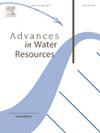坝体滑脱过程的SPH模拟。弗劳德相似性的局限性
IF 4.2
2区 环境科学与生态学
Q1 WATER RESOURCES
引用次数: 0
摘要
应用光滑粒子流体力学(SPH)模拟了土坝上覆溃坝的质量分离过程。SPH能够在原型和实验室模型尺度上模拟自由表面流动。漫过水坝的水流是由重力驱动的。因此,弗劳德相似性被用于将结果从模型扩展到原型,即使存在流体-壁面相互作用。特别是,控制从坝体分离的固体与决口水流之间相互作用的过程可能不服从弗劳德相似。在本文中,我们讨论几何尺度如何影响质量分离对溃坝流场的影响,以及SPH模拟工具如何表达这些尺度问题。等温流动中弱可压缩流体和牛顿流体的Navier-Stokes方程用于水的流动。采用动态边界条件求解流坝相互作用。所有的模拟都是在dualspphysics中进行的,采用弱可压缩光滑粒子流体力学(WCSPH)方案。分离土体被建模为刚性块体。通过耦合dualspphysics和非光滑多体动力学模型(Chrono-Engine),获得了分离块体与通过裂口的流体之间的相互作用。用粒子跟踪测速仪(PTV)测定质量分离过程中的表面速度场,用于评价SPH溶液的质量。数值速度场与观测速度场在包含块体分离的时移过程中表现出较好的一致性。然而,当水流接近决口时,流线的曲率存在差异,这表明需要仔细研究SPH模拟工具的假设。落块对流场的影响随模型坝的大小而显著不同。在简化模型中,块体并没有完全从缺口中运输出来。这配置了弗劳德相似度的分解,在某种意义上,模型上的水动力作用相对于原型来说不成比例地小。虽然可能有物理原因在起作用,但我们注意到,确保模型中的质量守恒会导致较小的初始分辨率,这可能会影响SPH和Chrono模拟工具之间的力传递方式。本文章由计算机程序翻译,如有差异,请以英文原文为准。
SPH modelling of mass detachment processes in overtopped dams. The limits of Froude similarity
We apply Smooth Particle Hydrodynamics (SPH) to simulate mass detachments in an overtopped and breached earth dam. SPH is able to model free surface flows at prototype and laboratory model scales. The flow over the overtopped dam is gravity-driven. Froude similarity is thus employed to scale results from models to prototypes, even if there are fluid-wall interactions. In particular, the processes that govern the interaction between a detached solid from the dam body and the breach flow may not obey Froude similarity. In this paper, we discuss how the geometric scale conditions the effects of mass detachments on the flow field of a breached dam and how SPH simulation tools express these scaling issues. The Navier–Stokes equations for weakly compressible and Newtonian fluids in isothermal flows were used for the water flow. Flow-dam interaction was resolved with dynamic boundary conditions. All simulations were conducted with DualSPHysics, employing the Weakly Compressible Smoothed Particle Hydrodynamics (WCSPH) scheme. The detached soil mass was modelled as a rigid block. The interaction between the detached block and the fluid flow through the breach was attained by coupling DualSPHysics with the non-smooth multi-body dynamics model (Chrono-Engine). The surface velocity field, determined with Particle Tracking Velocimetry (PTV) during the mass detachment, was used to assess the quality of the SPH solution. The numerical and the observed velocity fields show a reasonable agreement in the time-lapse that encompasses the detachment of the block. However, there are differences in the curvature of streamlines as the flow approaches the breach, suggesting a closer look at the hypotheis of the SPH simulation tool. The impact of the falling block on the flow field varies significantly with the size of the modelled dam. The block is not entirely transported out of the breach in the reduced model. This configures a breakdown of Froude similarity in the sense that hydrodynamic actions on the model are disproportionately smaller in the model relative to the prototype. While there may be physical reasons at play, we note that ensuring mass conservation in the model led to a smaller initial resolution that may have affected how forces are transmitted between the SPH and Chrono simulation tools.
求助全文
通过发布文献求助,成功后即可免费获取论文全文。
去求助
来源期刊

Advances in Water Resources
环境科学-水资源
CiteScore
9.40
自引率
6.40%
发文量
171
审稿时长
36 days
期刊介绍:
Advances in Water Resources provides a forum for the presentation of fundamental scientific advances in the understanding of water resources systems. The scope of Advances in Water Resources includes any combination of theoretical, computational, and experimental approaches used to advance fundamental understanding of surface or subsurface water resources systems or the interaction of these systems with the atmosphere, geosphere, biosphere, and human societies. Manuscripts involving case studies that do not attempt to reach broader conclusions, research on engineering design, applied hydraulics, or water quality and treatment, as well as applications of existing knowledge that do not advance fundamental understanding of hydrological processes, are not appropriate for Advances in Water Resources.
Examples of appropriate topical areas that will be considered include the following:
• Surface and subsurface hydrology
• Hydrometeorology
• Environmental fluid dynamics
• Ecohydrology and ecohydrodynamics
• Multiphase transport phenomena in porous media
• Fluid flow and species transport and reaction processes
 求助内容:
求助内容: 应助结果提醒方式:
应助结果提醒方式:


